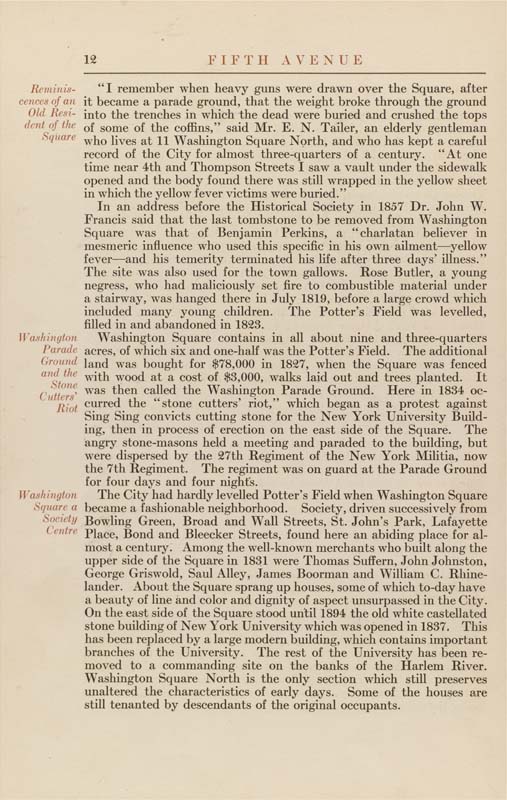12
FIFTH AVENUE
Reminis¬
cences of an
Old Resi¬
dent of the
Square
Washington
Parade
Ground
and the
Stone
Cutters'
Riot
Washington
Square a
Society
Centre
"I remember when heavy guns were drawn over the Square, after
it became a parade ground, that the weight broke through the ground
into the trenches in which the dead were buried and crushed the tops
of some of the coffins," said Mr. E. N. Tailer, an elderly gentleman
who lives at 11 Washington Square North, and who has kept a careful
record of the City for almost three-quarters of a century. "At one
time near 4th and Thompson Streets I saw a vault under the sidewalk
opened and the body found there was still wrapped in the yellow sheet
in which the yellow fever victims were buried."
In an address before the Historical Society in 1857 Dr. John W.
Francis said that the last tombstone to be removed from Washington
Square was that of Benjamin Perkins, a "charlatan believer in
mesmeric influence who used this specific in his own ailment—^yellow
fever—and his temerity terminated his life after three days' illness."
The site was also used for the town gallows. Rose Butler, a young
negress, who had maliciously set fire to combustible material under
a stairway, was hanged there in July 1819, before a large crowd which
included many young children. The Potter's Field was levelled,
filled in and abandoned in 1823.
Washington Square contains in all about nine and three-quarters
acres, of which six and one-half was the Potter's Field. The additional
land was bought for $78,000 in 1827, when the Square was fenced
with wood at a cost of $3,000, walks laid out and trees planted. It
was then called the Washington Parade Ground. Here in 1834 oc¬
curred the "stone cutters' riot," which began as a protest against
Sing Sing convicts cutting stone for the New York University Build¬
ing, then in process of erection on the east side of the Square. The
angry stone-masons held a meeting and paraded to the building, but
were dispersed by the 27th Regiment of the New York Militia, now
the 7th Regiment. The regiment was on guard at the Parade Ground
for four days and four night's.
The City had hardly levelled Potter's Field when Washington Square
became a fashionable neighborhood. Society, driven successively from
Bowling Green, Broad and Wall Streets, St. John's Park, Lafayette
Place, Bond and Bleecker Streets, found here an abiding place for al¬
most a century. Among the well-known merchants who built along the
upper side of the Square in 1831 were Thomas Suffern, John Johnston,
George Griswold, Saul Alley, James Boorman and William C. Rhine-
lander. About the Square sprang up houses, some of which to-day have
a beauty of line and color and dignity of aspect unsurpassed in the City.
On the east side of the Square stood until 1894 the old white castellated
stone building of New York University which was opened in 1837. This
has been replaced by a large modern building, which contains important
branches of the University. The rest of the University has been re¬
moved to a commanding site on the banks of the Harlem River.
Washington Square North is the only section which still preserves
unaltered the characteristics of early days. Some of the houses are
still tenanted by descendants of the original occupants.
|








